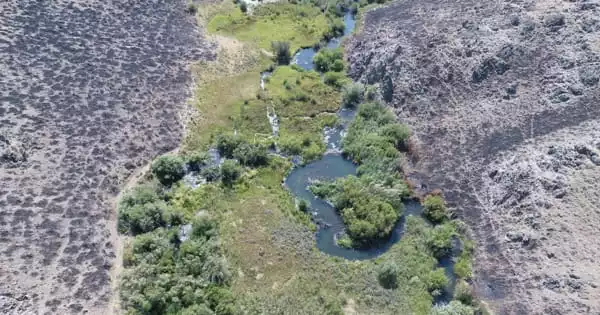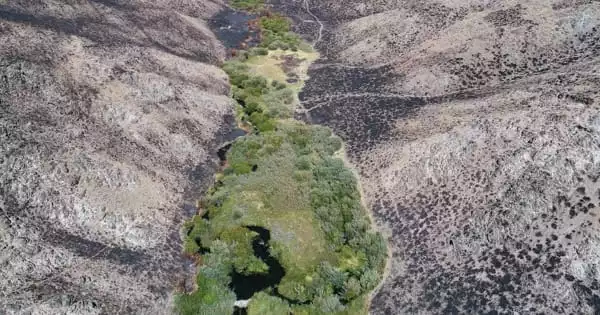Three dozen personnel from the United States Department of Agriculture’s Natural Resources Conservation Service stood at a little creek in the parched sagebrush of southeastern Idaho, wearing waders and work gloves. The group was excited to learn how to fix a stream the oldfashioned way.
Rancher Jay Wilde, 73, tipped back his white cowboy hat and informed the audience that he grew up swimming and fishing at Birch Creek all summer. However, when he took over the family farm from his parents in 1995, the stream was dry by mid-June.
Wilde realized this was due in part to the fact that his family and neighbors, like generations of American settlers before them, had trapped and removed the majority of the dam-building beavers. The settlers also built roads, felled trees, mined streams, overgrazed cattle, and erected flood-control and irrigation structures, all of which altered the plumbing of watersheds such as Birch Creek’s.
Since the 1700s, many wetlands in the western United States have vanished. California has lost an astounding 90% of its wetlands, which include streambanks, wet meadows, and ponds. More than half of the wetlands in Nevada, Idaho, and Colorado have perished. Precious moist ecosystems today account for only 2% of the arid West, and those that remain are failing.
According to Jeremy Maestas, a sagebrush ecosystem specialist with the NRCS who organized the workshop on Wilde’s ranch in 2016, over half of U.S. streams are in poor condition, unable to completely sustain wildlife and people. As towns in the American West face increased water scarcity, more frequent and larger wildfires, and unexpected floods, rehabilitating sick streams is becoming a need.
Landowners and conservation groups, such as the NRCS, are assembling teams of volunteers and laborers to construct low-cost solutions out of sticks and stones. And the work is having an impact. Streams are running longer into the summer, beavers and other wildlife are returning, and a study published in December revealed that beaver-irrigated landscapes can withstand wildfires.
California has lost an astounding 90% of its wetlands, which include streambanks, wet meadows, and ponds. More than half of the wetlands in Nevada, Idaho, and Colorado have perished.
Jeremy Maestas
Filling the sponge
Consider a floodplain to be a sponge: Floodplains in the West absorb up snow melting from the mountains each spring. During the summer and fall, when the snow has melted and rainfall is rare, the sponge is wrung out. The longer streams can run and plants can survive, the more water that remains in the sponge. Because damp locations full of green plants can reduce floods, endure droughts, and stifle fires, a full sponge improves the landscape’s ability to withstand natural disasters.
According to Joseph Wheaton, a geomorphologist at Utah State University in Logan, typical modern-day stream and river restoration procedures can cost up to $500,000 per mile. Projects are often complex, and involve excavators and bulldozers to shore up streambanks using giant boulders or to construct brand-new channels.
“Even though we spend at least $15 billion per year repairing waterways in the U.S., we’re hardly scratching the surface of what needs fixing,” Wheaton says. Big yellow machines are certainly necessary for restoring big rivers. But 90 percent of all U.S. waterways are small streams, the kind you can hop over or wade across.
Hand-built restoration methods work well for smaller streams, often at a fraction of the cost, and can be self-sustaining once nature takes over, according to Wheaton. Building beaver dam analogs to lure beavers to stay and work, establishing small rock dams, or strategically mounding mud and branches in a stream are examples of low-tech tactics. The purpose of these basic constructions is to delay the flow of water and distribute it across the floodplain, allowing plants to thrive and filling the subsurface sponge.
Fixes like these aid in the treatment of a widespread ailment that afflicts most streams in the West, including Birch Creek, according to Wheaton: Human activity has transformed these streams into straighter, debris-free channels. As a result, the majority of riverscapes are too straight and too rapid.

“They should be disorganized and inefficient,” he claims. “They require additional structure, whether it’s made of wood, rock, roots, or earth.” That is what causes the water to slow down.” Wheaton favors “riverscape” to “stream” or “river” because he “can’t image a thriving river without including the area surrounding it.”
Natural buildings, he claims, “give the stream a nutritious diet” of natural materials, allowing soil and water to re-accumulate in the floodplain. Because up to 75 percent of water resources in the West are on private land, conservation groups and government agencies such as the NRCS are assisting ranchers and farmers in improving their property’s streams, springs, and wet meadows.
Beaver benefits
Beavers can play an important role in replenishing the floodplain’s sponge in watersheds across the West. Rodents nibble down trees to build lodges and dams, and they dig channels to bring logs to the dams. All of this effort slows and spreads the water.
Streamsides near beaver dams on two rivers in northeastern Nevada were up to 88 percent greener than undammed stream portions when tested between 2013 and 2016. Even better, beaver ponds helped maintain lush vegetation during the hottest summer months, even during a multiyear drought, according to Emily Fairfax, an ecohydrologist at California State University Channel Islands, and geologist Eric Small of the University of Colorado Boulder, who published their findings in the journal Ecohydrology in 2018.
“Bringing beavers back just makes good common sense when you get down to the science of it,” Wilde says. He did it on his ranch.
The use of beavers to repair watersheds is not a novel concept. Idaho Fish and Game biologists, for example, parachuted beavers out of planes in 1948, partly to restore trout habitat on public lands.
Instead of parachutes, Wilde employed trucks. In 2015 and 2016, he collaborated with the US Forest Service and Idaho Fish and Game to livetrap and move nine beavers from public lands about 120 kilometers distant to Birch Creek. Wilde collaborated with Anabranch Solutions, a riverscape restoration company cofounded by Wheaton and colleagues, to build 26 beaver dam analogs to guarantee the released rodents had a few initial ponds where they might escape predators. Would the beavers be enticed to stay in Birch Creek by these modest branch-and-post structures?
It worked perfectly. In just three years, those beavers erected 149 dams, transforming the once-thin green strip along the creek into a huge, flourishing floodplain. Birch Creek flowed for 42 days longer, during the hottest months of the year. Fish populations recovered swiftly as well: native Bonneville cutthroat trout populations were up to 50 times as common in the ponded portions in 2019 as they were when the US Forest Service assessed them in 2000, before the beavers arrived.
“It’s almost like magic when you see the results,” Wilde explains. Even more enthralling, Wilde’s metamorphosis cost only “a couple hundred dollars in fence posts” and a few days of sweat work, owing in part to the NRCS staffers who visited in 2016 and a slew of volunteers.





